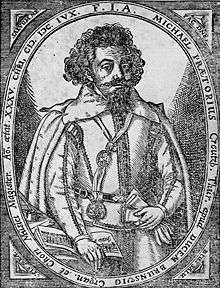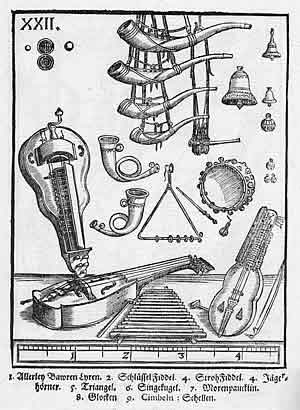Michael Praetorius
Michael Praetorius (probably 28 September 1571[1] – 15 February 1621) was a German composer, organist, and music theorist.[2] He was one of the most versatile composers of his age, being particularly significant in the development of musical forms based on Protestant hymns.

Life
Praetorius was born Michael Schultze, Schultheis, or Schultz, the youngest son of a Lutheran pastor, in Creuzburg, in present-day Thuringia. After attending school in Torgau and Zerbst, he studied divinity and philosophy at the University of Frankfurt (Oder). He was fluent in a number of languages. After receiving his musical education, from 1587 he served as organist at the Marienkirche in Frankfurt. From 1592/3 he served at the court in Wolfenbüttel, under the employ of Henry Julius, Duke of Brunswick-Lüneburg. He served in the duke's State Orchestra, first as organist and later (from 1604) as Kapellmeister (court music director).[3]
His first compositions appeared around 1602/3. Their publication primarily reflects the care for music at the court of Gröningen. The motets of this collection were the first in Germany to make use of the new Italian performance practices; as a result, they established him as a proficient composer.
These "modern" pieces mark the end of his middle creative period. The nine parts of his Musae Sioniae (1605–10) and the 1611 published collections of liturgical music (masses, hymns, magnificats) follow the German Protestant chorale style. With these, at the behest of a circle of orthodox Lutherans, he followed the Duchess Elizabeth, who ruled the duchy in the duke's absence.
When the duke died in 1613 and was succeeded by Frederick Ulrich, Praetorius retained his post in Wolfenbüttel. But he also began working at the court of John George I, Elector of Saxony at Dresden as Kapellmeister von Haus aus (nonresident music director). There he was responsible for festive music and was exposed to the latest Italian music, including the polychoral works of the Venetian School.[4] His subsequent development of the form of the chorale concerto, particularly the polychoral variety, resulted directly from his familiarity with the music of such Venetians as Giovanni Gabrieli. The solo-voice, polychoral, and instrumental compositions Praetorius prepared for these events mark the high period of his artistic creativity. Gottfried Staffel’s detailed eyewitness account of Praetorius’s music directing at the 1614 Princes’ Convention (Fürstentag) in Naumburg[5] and Matthias Hoë von Hoënegg’s epigram describing the impression Praetorius’s music made on Emperor Matthias and other princes during a visit to Dresden in the summer of 1617[6] provide some sense of Praetorius’s fame at the time. In Dresden Praetorius also worked and consulted with Heinrich Schütz from 1615–1619.
It seems that Praetorius’s appointment in Wolfenbüttel was no longer being renewed by Trinity Sunday of 1620.[7] He was probably already lying sick in bed in Wolfenbüttel by that time. There he died on February 15, 1621, at age forty-nine. His body was entombed in a vault beneath the organ of the Marienkirche on February 23.[8]
Name
His family name in German appears in various forms including Schultze, Schulte, Schultheiss, Schulz and Schulteis. Praetorius was the conventional Latinized form of this family name,[3] Schultze meaning "village judge or magistrate" in German. The Latin Praetorius means "magistrate-related or one with the rank of a magistrate."[9]
Works

Praetorius was a prolific composer; his compositions show the influence of Italian composers and his younger contemporary Heinrich Schütz. His works include the 17 volumes of music published during his time as Kapellmeister to Duke Heinrich Julius of Wolfenbüttel, between 1605 and 1613. The most significant of these publications is the nine-part Musae Sioniae (1605–10), a collection of chorale and song arrangements for 2 to 16 voices.[11] He wrote many other works for the Lutheran church; and Terpsichore, a compendium of more than 300 instrumental dances, which is both his most widely known work, and his sole surviving secular work.
Many of Praetorius' choral compositions were scored for several smaller choirs situated in several locations in the church, in the style of the Venetian polychoral music of Gabrieli.[11][12]
Praetorius composed the familiar harmonization of Es ist ein Ros entsprungen (Lo, How a Rose E'er Blooming) in 1609.[13]
Organ works
- Christ, unser Herr, zum Jordan kam – Fantasia (Musæ Sioniæ VII, 1609)
- Ein’ feste Burg ist unser Gott – Fantasia (Musæ Sioniæ VII, 1609)
- Wir glauben all an einen Gott – Fantasia (Musæ Sioniæ VII, 1609)
- Nun lob, mein Seel, den Herren – 2 Variationen (Musæ Sioniæ VII, 1609)
- Alvus tumescit virginis – Advent-Hymnus « Veni redemptor gentium » (Hymnodia Sionia, 1611)
- A solis ortus cardine – Weihnachts-Hymnus (Hymnodia Sionia, 1611)
- Summo Parenti gloria – (8. A solis ortus cardine) (Hymnodia Sionia, 1611)
- Vita sanctorum – Oster-Hymnus (Hymnodia Sionia, 1611)
- O lux beata Trinitas – Dreifaltigkeits-Hymnus (Hymnodia Sionia, 1611)
- Te mane laudum carmine – (2. O lux beata Trinitas) (Hymnodia Sionia, 1611)
- Sinfonia zu « Gelobet und gepreiset sei Gott Vater » (Polyhymnia Caduceatrix et Panegyrica, 1619)
Musical writings
Praetorius was the greatest musical academic of his day and the Germanic writer on music best known to other 17th-century musicians.[14] Although his original theoretical contributions were relatively few, with nowhere near the long-range impact of other 17th-century German writers, like Johannes Lippius, Christoph Bernhard or Joachim Burmeister, he compiled an encyclopedic record of contemporary musical practices. While Praetorius made some refinements to figured-bass practice[15] and to tuning practice, his importance to scholars of the 17th century derives from his discussions of the normal use of instruments and voices in ensembles, the standard pitch of the time, and the state of modal, metrical, and fugal theory. His meticulous documentation of 17th-century practice was of inestimable value to the early-music revival of the 20th century.
His expansive but unfinished treatise, Syntagma Musicum, appeared in three volumes (with appendix) between 1614 and 1620.[16] The first volume (1614), titled Musicae Artis Analecta, was written mostly in Latin, and regarded the music of the ancients and of the church. The second (De Organographia, 1618) regarded the musical instruments of the day, especially the organ; it was one of the first theoretical treatises written in the vernacular.[17] The third (Termini Musicali, 1618), also in German, regarded the genres of composition and the technical essentials for professional musicians. An appendix to the second volume (Theatrum Instrumentorum seu Sciagraphia, 1620) consisted of 42 beautifully drawn woodcuts, depicting instruments of the early 17th century, all grouped in families and shown to scale. A fourth volume on composition was planned, with the help of Baryphonus, but was left incomplete at his death. Gustave Reese said that the Syntagma Musicum was one of the most important sources of seventeenth century musical history.[4]
Praetorius wrote in a florid style, replete with long asides, polemics, and word-puzzles – all typical of 17th-century scholarly prose. As a lifelong committed Christian, he often regretted not taking holy orders but did write several theological tracts, which are now lost. As a Lutheran from a militantly Protestant family, he contributed greatly to the development of the vernacular liturgy, but also favored Italian compositional methods, performance practice and figured-bass notation.
References
- Praetorius’s birthdate (and even to a certain extent, birth-year) has long been shrouded in uncertainty. However, Appendix II of the biography Heaven Is My Fatherland (2020) establishes for certain that Praetorius was born in 1571 and not prior to February 16. It also provides strong evidence that he was born on September 27 or 28, the day before St. Michael’s Day. He was then most likely baptized on St. Michael’s Day and named after the saint of the day. The often erroneously cited 15 February birthdate is based on an encyclopedic resource published in 1721, whose information appears to have stemmed from a misunderstanding of Praetorius’s epitaph.
- Walter Blankenburg and Cletus Gottwald, "Praetorius, Michael. In Grove Music Online. Oxford Music Online, (accessed September 11, 2011)
- "Michael Praetorius", The Kennedy Center (archive from 3 February 2013; accessed 22 June 2016)
- Ruth Watanabe, "Michael Praetorius and His Syntagma Musicum", University of Rochester Library Bulletin, Vol. X. Spring 1955. Number 3
- Siegfried Vogelsänger, Heaven Is My Fatherland: The Life and Work of Michael Praetorius, translated and edited by Nathaniel J. Biebert (Eugene, OR: Resource Publications, 2020), 201–217.
- Ibid., 100.
- Arno Forchert, “Praetorius, Michael,” in Die Musik in Geschichte und Gegenwart Personenteil, 13:886.
- Vogelsänger, op. cit., 108–9, 169–70. See also n. 1.
- Ibid., 1.
- "Courante". Britannica.com. Retrieved September 27, 2019.
- "Musae Sioniae". Collegium Vocale Gent. Retrieved 10 May 2020.
- http://www.newhopelc.org/#!lutheran-musical-heritage/c961
- Historical Notes, and additional English versions, from The Hymns and Carols of Christmas
- George J. Buelow, “Symposium on Seventeenth-Century Music Theory: Germany”, Journal of Music Theory16 (1972): 36–49.
- Hermann Keller, Schule des Generalbass-Spiels (1931); appeared in English translation, by Carl Parrish, as Thoroughbass Method (1965).
- Facsimile edition, edited by Wilibald Gurlitt, published by Bärenreiter in 1959.
- See the translation of the first two parts of this volume, by David Z. Crookes, published by Oxford University Press in 1986.
Sources
- Denis Arnold (editor), (1983), New Oxford Companion to Music, Oxford University Press. (Article by editor.)
- Quentin Faulkner (translator and editor), (2014) Syntagma Musicum II: De Organographia, Parts III – V with Index (Wolfenbüttel, 1619) Zea Books
- Jeffery T. Kite-Powell (translator and editor), (2004) Syntagma Musicum III: Termini musici (Wolfenbüttel, 1619) Oxford University Press.
- Stéphan Perreau (1996). Liner notes to Praetorius: Dances from Terpsichore. Naxos 8.553865.
Further reading
- Vogelsänger, Siegfried. Heaven Is My Fatherland: The Life and Work of Michael Praetorius. Translated and edited by Nathaniel J. Biebert. Eugene, OR: Resource Publications, 2020.
External links
| Wikimedia Commons has media related to Michael Praetorius. |
- Free scores by Michael Praetorius in the Choral Public Domain Library (ChoralWiki)
- Free scores by Michael Praetorius at the International Music Score Library Project (IMSLP)
- Complete works by Praetorius in modern edition.
- Michael Praetorius, biography on Goldberg, the Early Music Portal.
- Michael Pratorius – facsimiles in The Royal Library, Copenhagen
- Listen to free Vocal Evangelical Church Music by Michael Praetorius at "Early Vocal Music Map" from Umeå Akademiska Kör.
- Works by or about Michael Praetorius at Internet Archive
- Works by Michael Praetorius at LibriVox (public domain audiobooks)


